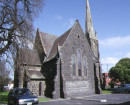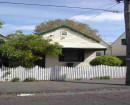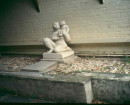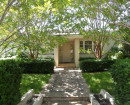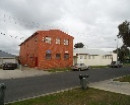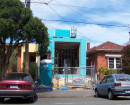Private Survey Heritage Precinct
Albert Street, Alfred Place, Alma Terrace, Bath Place, Blucher Terrace, Braw Street, Bronte Court, Bunbury Street, Chandler Street, Clark Street, Clough Street, College Street, Courtis Street, Cox's Garden, Crawford Street, Dalgarno Street, Davies Street,
-
Add to tour
You must log in to do that.
-
Share
-
Shortlist place
You must log in to do that.
- Download report
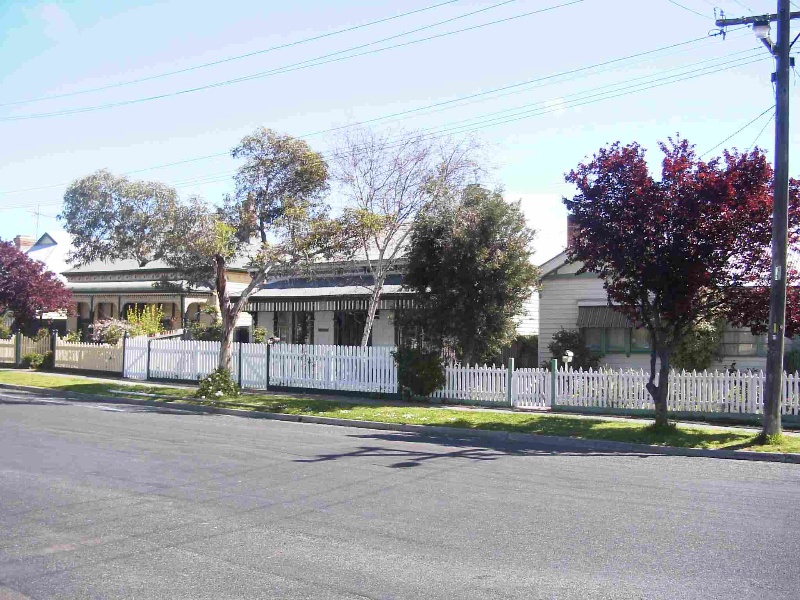

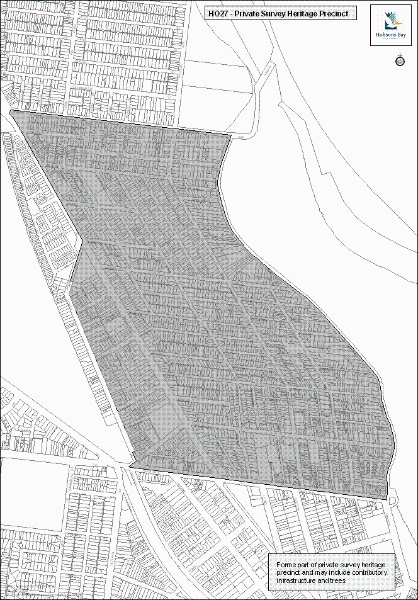
Statement of Significance
The Private Survey Heritage Precinct, which comprises all land within HO27 and is generally bounded by North Road, The Strand, Ferguson Street, Power Street and Melbourne Road in Williamstown and Newport.
How is it Significant?
The Private Survey Heritage Precinct is of local historic, social and aesthetic significance to the City of Hobsons Bay.
Why is it Significant?Historically, the Private Survey precinct is significant for its ability to illustrate the early private subdivision that began to the north of Ferguson Street soon after the formal surveying of the Government Town to the south of Ferguson Street. It demonstrates the influence of the two main development phases of the city during the Victorian (port rise and decline) and Edwardian to Interwar periods (railway and manufacturing industry), which have created a distinctive historic development pattern that is different from the Government Survey precinct to the south of Ferguson Street. (AHC criteria A4 and D2)
Socially, the Private Survey precinct is significant for its ability to demonstrate how distinctive and often self-contained communities developed in Williamstown during the nineteenth and early twentieth centuries. (AHC criteria G1)
Aesthetically, the Private Survey is significant for the groups of predominantly late nineteenth and early twentieth century houses that, although stylistically different, share common elements of scale, siting, materials and roof forms, which create cohesive groups of distinctive character. Some streets retain early street detailing such as basalt kerb and channel and mature street trees, which enhance and reinforce the historic character. In addition:
- Alma Terrace is notable for its intact groups of Victorian double fronted villas.
- Chandler Street is notable as a nearly intact street with an almost homogeneous Interwar character.
- Douglas Parade, Melbourne Road and Stevedore Streets are notable for the commercial buildings on prominent corner sites that set these streets apart from the predominantly residential streets in the area.
- The east side of Eliza Street is notable for its intact group of Victorian single fronted villas and one double fronted brick villa.
- Federal Street is notable as a nearly intact street with an almost homogeneous Interwar character.
- The north side of Wilkins Street is notable for its groups of single and double fronted Victorian villas.
(AHC criterion E1)
Please note that some heritage places within this precinct may also have an individual citation in this Study. There are also individual citations for Cox's Garden, Ferguson Street, James Street, John Street (including part of Dover Road), Lenore Crescent, Macquarie Street, Power Street, The Strand and the commercial precinct at 316-344 Melbourne Road, which have more specific statements of significance.
On this basis, the properties in the following streets contribute to the significance of the precinct:
-Albert Street (odd) 7, 11, 13, 15, 25 (rear), 33, 35, 37, 53, 55 and 67 (even) 14, 18, 20, 24, 28, 40, 42, 44-46, 48, 64, 68, 70 nd 72.
-Alfred Place (odd) 7 and 11.
-Alma Terrace (odd) 1-7, 11, 17, 21-25, 31, 35, 39, 45, 49-57, 61-65, 69, 71 and 77-81 (even) 12-16, 34, 44-48, 52, 54, 58, 60, 66, 68, 72-76, 78, 80 and 82.
-Bunbury Street (odd) 11, 13, 23-27, 33-37 and 55-61 (even) 2, 4, 8-14, 28, 30, 34, 36, 54 and 60.
-Chandler Street (odd) 37-55 (even) 10-22, 26, 28, 32-36, 38 and 42-48.
-Clark Street (even) 24.
-College Street (odd) 9 (even) 24.
-Courtis Street (odd) 3, 3A-11, 17, 21-25 (even) 2, 4, 8-18.
-Cox's Garden (odd) 11 (even) 4, 10, 12 and 14. (Note: Refer to Cox's Garden Heritage Precinct (HO2)
-Crawford Street (odd) 1-5, 9, 13, 27, 31 and 33 (even) 2, 6-20 and 46.
-Dalgarno Street (odd) 13 and 15 (even) 14 and 16.
-Davies Street (odd) 1-11 and 35 (even) 2-16 and 28.
-Douch Street (odd) 3, 5 and 9 (even) 2, 6 and 10-14.
- Douglas Parade (odd) 37-43, 65, 83, 91, 93, 95-99, 117, 121-123, 133, 149, 151-159, 161, 163-
-163A, 169, 171, 175-179, 181, 199, 221-239, 251, 255, 259, 261, 265, 267, 269-277, 279-291, 295, 297 and 299 (even) 60-64, 118, 122-124, 126, 146, 150, 176-186, 192, 202, 236 and 282-292. (Note: The area north of North Road is included within Grindlay's Estate Heritage Precinct (HO10) and Halls Farm Heritage Precinct (HO11))
-Dover Road (odd) 5, 7, 17, 19, 33, 35, 43, 59, 69, 79 and 95 (even) 14, 18-20, 24, 36-44, 66, 68, 70, 98, 100, 106, 108, 112, 16 and 118. (Note: (odd) 33 and 35 (even) 36-44 are located in the Dover Road & John Street Heritage Precinct (HO3))
-Effingham Road (odd) 3-9 (even) 2, 6 and 12.
-Eliza Street (even) 2-16.
-Federal Street (odd) 5-17 (even) 2-10 and 14-18.
-Ferguson Street (even only) 2, 4, 20-22, 28, 36-44, 50-58, 62, 66, 78-112, 116-120, 144-146, 176, 182, 184, 190 and 194. Refer to Ferguson Street Civic & Commercial Heritage Precinct HO7).
-Freyer Street (odd) 1, 3 and 11-21 (even) 2-18.
-Haslam Street (odd) 7-19 and 31.
-Henry Street (odd) 1 and 3 (even) 2-8.
-Hosking Street (odd) 1-5, 15, 19, 21 and 23 (even) 2-18 and 22-36.
-Hotham Street (odd) 3, 7, 17, 19 and 27 (even) 12, 18, 22 and 24.
-James Street (odd) 1-11, 15-19 (even) 2, 4, 8, 10, 14, 18, 20 and 22. (Refer to James Street Heritage Precinct (HO17)).
-John Street (odd) 3, 5, 7, 13-17, 19, 43, 55, 59, 61 and 73-81a, 87-107 (even) 4-10, 16, 18, 24-32, 42, 62, 66-82 and 86-108. Note: (odd) 3-37 (even) 4-32 are included in the Dover Road & John Street Heritage Precinct (HO3)).
-Latrobe Street (odd) 3, 5 and 15 (even) 4-8, 12 and 16-20.
-Lenore Crescent (odd) 1-11, 15 and 17 (even) 2, 4, 8 and 12-16. .
-Maclean Street (odd) 9 and 13 (even) 16.
-Macquarie Street (odd) 1-9 and 13-19 (even) 4, 6, 10, 12, 16 and 18 (Refer to Macquarie Street Heritage Precinct (HO19)).
-Mariner Street (odd) 11, 17, 19 and 27 (even) 24.
-Melbourne Road (odd) 109, 111, 119, 125, 143, 145, 149-163, 171-177, 191-195, 199, 205 and 211 (even) 90-112, 122-128, 138, 140, 148, 148A-156, 164-178, 180, 188, 190, 192, 196, 198, 200, 202, 204, 210-220, 230, 232, 242-250, 262, 264, 272-274, 276, 278-282, 298, 300, 302-306, 316, 328-338 and 344 (Note: The area south of Ferguson Street is included within the Government Survey Heritage Precinct (HO8) and the area north of North Road is within the Newport Civic & Commercial Heritage Precinct (HO22)).
-North Road (odd only) 29, 31, 47-61, 69, 89, 99, 109, 113, 115, 121 and 125-131 (Note: The north side is included within the Grindlay's Estate Heritage Precinct (HO10)).
-Oakbank Street (odd) 3, 5, 7, 11, 13, 15, 23, 35-39, 47-53, 57, 59, 63, 67, 69, 75, 79 and 81 (even) 2, 4, 6, 8, 12, 14, 18, 22, 24, 28, 30, 32, 34, 36, 40-52, 60, 64 and 66.
-Paine Street (odd) 1, 3, 7, 9 and 11 (even) 4.
-Pearson Street (even) 4.
-Peel Street (odd) 1 (note - 1a &1b are non-contributory), 7-13, 25, 27, 33-37, 43, 47-65, 69 (even) 4-8, 24, 30-34, 44, 48, 52-58 and 62-66.
- Pentland Street (even) 2, 4-6, 8-10, 12 and 14.
- Power Street (even) 2A, 8-28, 32-54, 58A, 62, 64, 68, 74-88, 94, 98-104, 110-120 and 128-132 (Tennis Club Pavilion)(Refer to Power Street Heritage Precinct (HO26)).
-Princes Street (odd) 9, 11, 15-19, 25, 27, 37-47, 51-55, 59, 63, and 71-79 (even) 8, 10, 20-30, 44-48, 54, 56 and 60-64.
-Queen Street (even) 4, 6, 32 (Rear, facing 25 Albert Street) and 36.
-Rennie Street (even) 4-6, 8-10, 12, 14, 20 and 22.
-Richard Street (odd) 21 (even) 2, 4, 6, 8, 10, 12 and 14.
-Russell Place (odd) 7, 9 and 11, 13, 21-33 (even) 6, 8, 14, 16, 20-26 and 32-62.
-Station Road (odd) 1, 7, 13 and 19 (even) 20-24 and 34.
-Stevedore Street (odd) 11, 13, 21, 45, 53-57, 81, 83, 101, 103, 105, 117 and 119 (even) 2, 8, 10, 16-24, 46-54, 80-92, 110 and 112 (Note: Nos 80-92 are located within the Macquarie Street Heritage Precinct (HO19)).
-The Strand (odd and even) 4, 5, 8-9, (fences only) 10-14, 22, 24, 27, 28, 30, 53, 62, 63, 67-68, 69, 74, 75, 77 and 94.
-Thomas Street (even) 20 and 28.
-White Street (odd) 1-9, 15-21, 25, 27 (even) 20, 22.
-Wilkins Street (odd) 1, 3, 23, 25, 27, 41, 43 and 83 (even) 10-18, 20, 22-26, 34-46, 52, 54, 56, 70, 72, 78-86 and 92.
-Yarra Street (odd) 1, 15, 27, 37, 39, 45-55, 59, 77, 81, 83, 87 and 91-95 (even) 22, 24, 40, 42, 46-50A, 56, 62, 64, 68, 70, 74, 78 80, 86, 90 and 92.
-
-
Private Survey Heritage Precinct - Physical Description 1
The Private Survey precinct includes the predominantly residential area to the north of Ferguson Street, which is otherwise bounded by Power Street, Melbourne Road, North Road and The Strand, in Williamstown and Newport. This precinct includes the following sub-precincts that are described in more detail in separate citations in this Study:
- Cox's Gardens
- James Street
- John Street (Dover Road to The Strand only, includes 33-35 and 36-44 Dover Road)
- Lenore Crescent
- Melbourne Road Commercial (316-344 Melbourne Road, Newport)
- Macquarie Street and 80-100 Stevedore Street (even side only)
- Power Street
- The Strand
The precinct comprises a mix of predominantly single storey weatherboard housing from the late nineteenth and early twentieth centuries, with commercial buildings on corner sites and along main roads such as Melbourne Road and Douglas Parade. The layout is more irregular than the Government Survey and reflects the uncoordinated, speculative history of subdivision, which occurred over a 100 year period. Compared to the Government Survey, it is predominantly characterized by narrow street widths, often with small frontages and more irregularly shaped lots. The east west streets generally run parallel with Ferguson Street, while the orientation of the slightly skewed 'north-south' streets was influenced by the alignment of Melbourne Road, and the Hobsons Bay foreshore.
The following descriptions set out the specific contributory elements within each street in this precinct that have a moderate to high degree of integrity and/or cohesion. There are no specific descriptions of:
- Streets such as Dover Road, Station Road or Stevedore Street that have low integrity (ie. a high proportion of non-contributory buildings).
- The streets or parts of streets in the individual sub-precincts listed above (Refer to separate citations except for the other parts of John Street and Melbourne Road as described below)
Alma TerraceThe north end of Alma Terrace (generally north of Bunbury Street) comprises predominantly detached and semi-detached timber Victorian houses with small set backs, interspersed with some Edwardian and inter-war houses. Small gardens set back the house from the street boundary. Siting is parallel to the street boundary. Integrity is moderate and cohesion is high as there are few post-war houses. This section has bluestone kerbs and gutters.
The south end of Alma Terrace (generally south of Bunbury Street) comprises a mixture of detached Edwardian, and inter-war bungalows, interspersed with some Victorian houses. The houses are set back from the street boundary by small gardens and are sited diagonally to it. Cohesion and integrity is moderate as there are some post-war houses in the street. The street has concrete kerbing, asphalt pavements. There is no nature strip, however, there are street trees.
Front fences in both sections are varied in style but predominantly low.
Bunbury StreetBunbury Street comprises a mixture of predominantly Victorian and inter-war era houses, set back from the street by small gardens. All are detached, single-storey, and mostly weatherboard with some built of brick. Front fences are varied in style but uniformly low. The cohesion is low and the integrity is moderate as there are some intrusive post-war houses. There is no nature strip, however, there are street trees.
Chandler StreetChandler Street between Alma Terrace and White Street is notable as a highly intact and cohesive precinct of predominantly single-storey, detached, timber Edwardian and inter-war bungalows, set back from the street by mature gardens. There are some original or early front fences, which are uniformly low. The street has bluestone kerbs and gutters, nature strips and mature street trees.
Courtis StreetCourtis Street predominantly comprises single-storey, detached, weatherboard Victorian houses and inter-war bungalows. There are a couple of detached Edwardian villas on the north side of the street. The houses have a small set back from the street boundary. Front fences are varied in style but uniformly low. The street is wide with native street trees. Cohesion is good and integrity is high as there are few post-war dwellings.
Crawford StreetCrawford Street predominantly comprises modest single-storey, detached, timber Victorian cottages interspersed with some inter-war houses. The integrity is low and cohesion is moderate as there are some post-war houses. Notable dwellings include the small timber Victorian cottage (similar to a miners cottage) at No. 27, and a group of very narrow, detached, timber Victorian cottages at Nos. 6-18. Front fences are varied in style but predominantly low. The street is narrow and there are nature strips with trees.
Douch StreetDouch Street predominantly comprises single-storey, double-fronted, detached, block-fronted Victorian houses, interspersed with some related inter-war houses. They have consistent set backs with small front gardens. Fences are not original, but are mostly low and sympathetic. Integrity is moderate as some houses have been refaced. Cohesion is good and integrity is high as there are few post-war houses. The street is wide and has nature strips with native street trees.
Douglas ParadeThe integrity of Douglas Parade has been diminished by later development, however, it retains a number of relatively cohesive groups of houses as follows:
- On the west side of Douglas Parade there are a number of groups, which comprise a mixture of predominantly Edwardian and Interwar single-storey houses, set back from the street by small front gardens. These are generally found to the north and just to the south of Wilkins Street, around Bunbury Street and south of Yarra Street. There is a mixture of high and low timber picket fences. Cohesion is fair and integrity is moderate as there are some post-war houses. The street has bluestone kerbing, and asphalt pavements with street trees.
- On the east side of Douglas Parade there are two key groups that generally comprise predominantly timber and brick Interwar villas set back from the road by small gardens. These are located in the vicinity of Thomas and Yarra Streets, and to the north and south of Peel Street. Fences vary - low and high brick, timber picket etc. Cohesion is good and integrity is high as there are few post-war dwellings. The street has bluestone kerbing, nature strip, concrete pavements and street trees.
Douglas Parade also includes a number of notable commercial buildings including shops with original or early shopfronts such Nos. 181, 159, 236 and 237. The two storey former Urwins Butcher, a two storey brick rendered and parapeted Victorian era building constructed c.1898 on the north west corner of Albert Street is a local landmark, which is remembered by the integral sign in the corner parapet. It is situated opposite another landmark, the Prince Albert Hotel, which is one of a number of individually significant buildings that have separate citations in this Study.
Eliza StreetThe east side of Eliza Street comprises an intact group of Victorian weatherboard single-fronted cottages, and one double-fronted Victorian Italianate brick villa. All houses have small set backs from the street boundary and front fences are low. Cohesion is good and integrity is high as there are no post-war dwellings.
Effingham StreetApart from two single-storey, block-fronted Italianate villas on the east side of the street, the remaining houses in Effingham Street are predominantly double-fronted symmetrical and asymmetrical single-storey Edwardian villas. All houses have small set backs from the street boundary and front fences are low. Cohesion is good and integrity is high as there are few post-war dwellings. The street is wide and has concrete kerbing on the west side and bluestone on the east.
Federal StreetFederal Street is notable as a highly intact and cohesive Interwar precinct that predominantly comprises bungalows with some English Domestic Revival style houses. The houses are a mixture of timber and brick, and have tiled and corrugated steel roofing. There are some original woven wire fences extant, and most fences are low. The street is characterised by the houses' deep set backs from the street boundary. The road is relatively narrow, but the street has a spacious feeling due to the nature strips and mature street trees together with the deep front setbacks. Kerbing is concrete.
Freyer StreetFreyer Street comprises mostly detached, single-storey, timber Edwardian houses and a few block-fronted Victorian, and Inter-war houses. They are set back from the street boundary by a small garden. Notable houses include the Edwardian bungalow at No. 1 and an English Domestic Revival villa at No. 21. Fences are low, but mostly non-original styles. Integrity and cohesion is good as there are few post-war dwellings. The street is wide with various native street trees.
Haslam StreetHaslam Street includes a notable group comprising the Victorian polychromatic double-fronted brick villa with a deep front setback at No. 7, and the adjoining Victorian brick terrace at Nos. 9-19 which are set close to the frontage. This is the only example of a Victorian-era brick terrace in Williamstown. There is also an early, although altered, double-fronted Victorian cottage at No. 31.
Henry StreetThe houses in Henry Street are all Interwar bungalows except for Nos. 1 and 3, which date from the Edwardian period (No. 1 possibly being the renovation of an earlier dwelling). The bungalows are single-storey, detached and timber. They are set back from the street boundary by a small front garden. There are some original woven wire front fences, and most are low. Integrity and cohesion is good as there are few post-war dwellings. The street is narrow, has concrete kerbs and has nature strips, but no street trees.
Hosking StreetThe north side of Hosking Street predominantly comprises late-Victorian and Edwardian single and double-storey, detached, timber cottages, while the south side comprises a mixture of nineteenth and twentieth century styles. Front fences are low. There is a consistency of scale and integrity and cohesion is generally good as there are few post-war houses. The street is wide and has a central plantation of trees.
John StreetJohn Street between Melbourne Road and Queen Street predominantly comprises single and double-fronted, detached, late-Victorian houses, and a few Edwardian and later styles. The houses are set back from the street boundary by a garden. Fences are not original, but are low and sympathetic. Integrity and cohesion is quite good as there are few post-war dwellings. There is also a group of Victorian cottages at Nos. 22-32. The street is wide, has concrete kerbs, asphalt footpaths and no street trees.
Latrobe StreetLatrobe Street is a mixture of nineteenth and twentieth century style houses, set back from the street by small gardens. All are detached, single-storey, mostly built of timber - some built of brick. There is a notable intact Interwar bungalow at No. 16 with an original fence and sympathetic garden. Otherwise, fences are low and of various styles. The cohesion is low and the integrity is moderate as there are some unrelated post-war dwellings. The street has concrete kerbing and wide nature strips with trees.
Melbourne RoadMelbourne Road predominantly comprises single-storey, detached, timber Victorian and Edwardian houses, interspersed with Interwar houses that are related in terms of their scale, materials, siting and roof forms. There are also some commercial buildings on corner sites such as 'The Beehive', an intact two storey Victorian shop at No 164, and an unusual Interwar Spanish Mission shop at No. 198. Set backs vary, but usually houses are separated from the street by a medium sized garden. Siting can be parallel or diagonal to the street boundary. Front fences are mostly low, however, there are some intrusive high fences. Cohesion is moderate and integrity is moderate as there are some post-war houses.
Notable houses include 'Cloverley' at No. 149, St Stephen's Manse at No. 177 (which forms part of a complex that includes the more recent church as well as the early church hall), and the two storey Queen Anne villa at No. 242.
For the properties at 316-344 Melbourne Road, please refer to the Melbourne Road Commercial heritage precinct citation.
North RoadThe south side of North Road now predominantly comprises postwar development that is unrelated to the historic development periods of this precinct. However, two pockets remain as follows:
- At the western end is a small group of predominantly Victorian era dwellings and shops that include the individually significant bluestone cottage at No. 115, and two storey former shop and residence at No. 127. There is also a single storey dwelling and shop at No. 129 that retains a rare example of an early shopfront, an altered early bluestone house at No. 131, altered early shops or houses at 123-125, and a single fronted Edwardian villa at 121.
- On either side of Hastings Road is a group of Victorian, Edwardian and inter war villas, which share common elements of siting, scale and detailing such as hip or gable roofs and materials.
(Note: The north side of North Road is included within the Grindlay's Estate Heritage Precinct)
Oakbank StreetThe south end between Bunbury and Yarra Streets is predominantly single-storey, detached, timber Victorian and Edwardian villas, with some inter-war bungalows. They are sited parallel to the street boundary and have small gardens. Front fences are low.
The north end comprises late Victorian cottage and double fronted villas, as well as Interwar bungalows with similar siting and set backs to southern end of the street. Houses are predominantly single-storey, with some double-storey, built of timber. Cohesion is good and integrity is moderate as there are some post-war houses. Front fences are mostly low.
Paine StreetPaine Street is a mixture of predominantly timber, and some brick, inter-war houses. They are set back from the street by small gardens. Cohesion is good and the integrity is good as there are few post-war houses, which are related in terms of scale and setbacks. The street is wide and has concrete kerbing and nature strips with trees.
Peel StreetPeel Street is a mixture of late Victorian, and Edwardian single-storey, detached, single and double-fronted timber villas, which are interspersed with weatherboard inter-war bungalows. All are set back from the street boundary by small front gardens. Fences are low and recent. Cohesion is low and integrity is moderate as there are some unrelated post-war houses.
The street is wide and has plantations of native trees at centres down the middle of the road. There is bluestone kerbing and nature strips without trees.
Princes StreetPrinces Street predominantly comprises single-storey, detached, timber Edwardian and Inter-war houses. However, on the south side of the street, at its eastern end, is a group of double-fronted detached, timber Victorian villas. All houses are set back from the street boundary by a small garden. Cohesion is moderate and integrity is moderate as there are some post-war houses. The street has bluestone kerbing on the north side and concrete on the south.
Russell PlaceThe north side of Russell Place comprises a group of predominantly late Victorian era symmetrical single or double fronted weatherboard villas with similar form, siting (small front and side setbacks), single storey scale, and detailing. Some have been altered. Fences are not original, but are low and most are sympathetic. Cohesion and integrity is high.
White StreetWhite Street includes a mixture of late nineteenth and early twentieth century houses. There is a group of late-Victorian houses on the west side of the street near Yarra Street. Small gardens set back the houses from the street boundary. Integrity is moderate and cohesion is also moderate as there are some post-war houses. Front fences are varied in style but predominantly low. The street is wide and has bluestone kerbing, nature strips with native trees and concrete footpaths.
Wilkins StreetWilkins Street predominantly comprises single-storey, detached, single and double-fronted timber Victorian villas. Most are sited parallel to the street boundary, except on the south side, where a group of predominantly inter-war bungalows are sited diagonally to the street boundary. Cohesion is good and integrity is moderate as there are few post-war houses. Front fences are varied in style but generally sympathetic and predominantly low. The street is wide and has concrete kerbing, nature strips in parts and street trees.
Yarra StreetYarra Street between Melbourne Road and Douglas Parade predominantly comprises single storey, detached inter-war bungalows interspersed with Victorian and Edwardian houses. Front fences are varied in style but are predominantly low. Cohesion is good and integrity is moderate as there are few post-war houses.
Private Survey Heritage Precinct - Integrity
Integrity
Unrelated postwar development disrupts the complete expression of the precinct as a whole, however there are streets and areas as described above, which remain relatively intact in terms of demonstrating an historic period of development or as a group with common or related aesthetic characteristics.
Private Survey Heritage Precinct - Usage/Former Usage
Context
The Private Survey provides a transition between the Government Survey precinct to the south of Ferguson Street and the Halls Farm and Grindlay Estate precincts to the north of North Road.
Private Survey Heritage Precinct - Historical Australian Themes
Principal Australian Historical Theme(s)
Making Suburbs
Private Survey Heritage Precinct - Physical Description 2
Associations
Various - Refer to individual citations
Heritage Study and Grading
Hobsons Bay - Hobsons Bay Heritage Study
Author: Hobsons Bay City Council
Year: 2006
Grading:
-
-
-
-
-
RESIDENCE
 Victorian Heritage Register H0487
Victorian Heritage Register H0487 -
ST HELLIERS
 Victorian Heritage Register H0560
Victorian Heritage Register H0560 -
FORMER PRESBYTERIAN MANSE
 Victorian Heritage Register H0229
Victorian Heritage Register H0229
-
..esterville
 Yarra City
Yarra City -
1 Alfred Crescent
 Yarra City
Yarra City -
1 Barkly Street
 Yarra City
Yarra City
-
-






